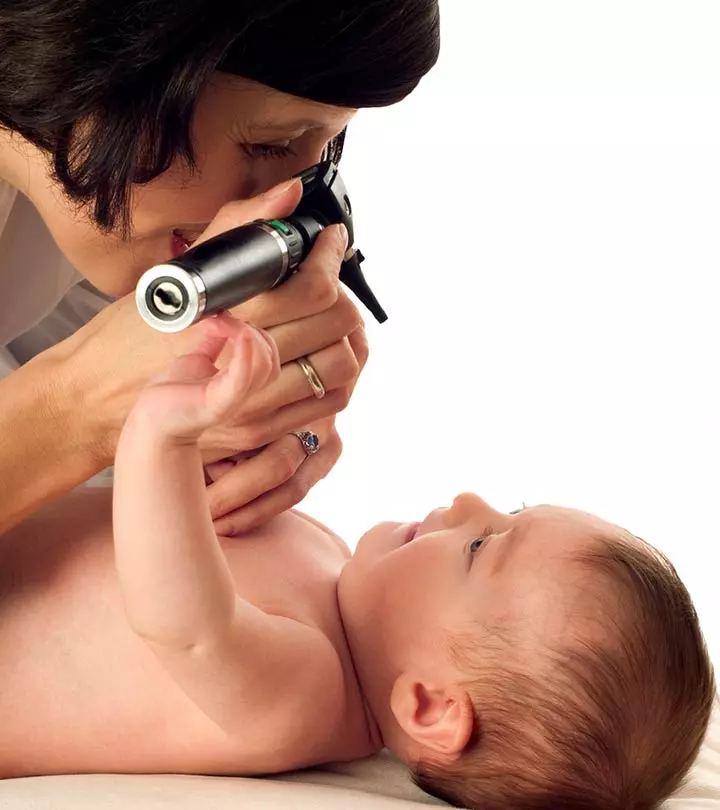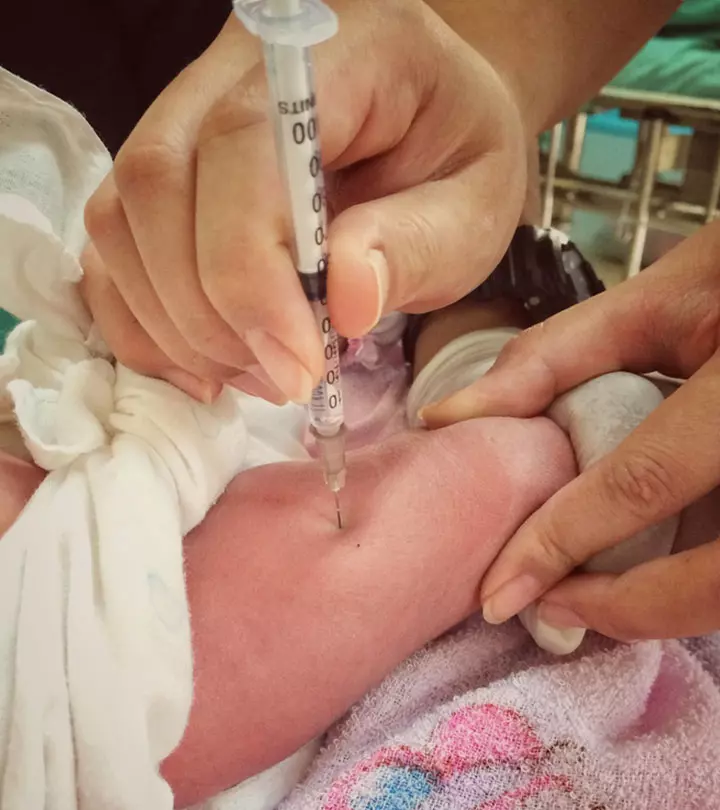
Image: Shutterstock
Dravet syndrome (DS) in babies is a rare genetic condition, previously referred to as severe myoclonic epilepsyiA brain-related phenomenon characterized by uncontrollable movements and loss of consciousness of infancy (SMEI) or epilepsy with polymorphic seizuresiA type of seizure characterized by a varied pattern of body movements .

It is characterized by temperature-sensitive epileptic seizures that usually begin in the first year of a baby’s life (1). Most individuals (more than 80%) with DS develop a mutation in a specific gene. Although, in some cases, mutations in more than a single gene may lead to the development of the syndrome (2). However, having a genetic mutation isn’t enough for the diagnosis.
Keep reading to learn the causes, symptoms, diagnosis, treatment, and management of Dravet syndrome in babies.
 Did you know?
Did you know?Key Pointers
- Dravet syndrome (DS) is a rare and severe epilepsy type that affects babies in the first year of life.
- Babies with DS may experience seizures that are difficult to treat with medications.
- Infants usually attain developmental milestones at a slower rate than their peers.
- Reviewing the baby’s development before seizures and seizure duration and type helps diagnose the condition.
- Timely and personalized medications and therapies can help alleviate seizures and long-lasting complications.
How Common Is Dravet Syndrome?
Dravet syndrome is rare and estimated to have an incidence of 1 in about 15,700 cases in the United States (2).
Furthermore, about 5% of babies with DS may experience a seizure within the first 12 months, and 7% of babies may develop the symptoms by three years of age (1). The disorder usually manifests in the first year of a child’s age or is diagnosed by their preschool age.
What Does Dravet Syndrome Look Like In Babies?

Image: IStock
The first and most noticeable sign of Dravet syndrome in babies is epileptic seizures, involving jerking muscular movements, particularly on one side of the body. The seizures are often varied, sudden, frequent, and prolonged. High fever usually accompanies the first epileptic seizure, but subsequent episodes may occur with or without fever. Experts indicate that factors such as illness or stress may trigger seizures in babies and they are often difficult to control with medications (2) (3).
Most infants during the early years of life may appear to be growing normally after an initial seizure. However, as the frequency of seizures increases, the rate at which they learn new skills may begin to decline (4).
What Are The Symptoms Of Dravet Syndrome?

Image: IStock
A convulsive seizure triggered by fever, typically around five to eight months, is the most common symptom of DS. However, a baby may exhibit other symptoms, which may include (2) (3) (5):
- Anxiety
- Movement disorders
- Sensory disorders
- Repeated infections
- Behavioral or developmental delays
- Speech or language delays
- Poor coordination or balancing skills (leading to walking difficulties)
- Emotional or academic challenges
- Abnormal heart rate or body temperature
- Feeding or sleeping difficulties
The symptoms of DS may vary from one baby to another and can range from mild to severe.
What Causes Dravet Syndrome?
Mutation in the SCN1A gene, which codes for sodium channels, is the fundamental cause of Dravet syndrome.
These channels are a vital component of the cell’s membranes, and a mutation in the SCN1A gene could impact the brain and nervous system’s functioning. This genetic change is responsible for the overactivity of the neurons, which might, in turn, lead to seizures and epilepsy (6).
The genetic mutationsiAlterations in the genetic makeup (DNA sequence) in an organism causing the ailment typically happen spontaneously and are not passed down through successive generations. However, in rare scenarios, babies with a parent or family member with the syndrome may also obtain it (5).
 Quick fact
Quick factFurthermore, certain genetic and environmental factors, including a male gender and a family history of epilepsy, might play a pivotal role in a baby acquiring DS (1). The syndrome may also be linked to gene mutations other than SCN1A, but this is rare (2).
How Is Dravet Syndrome Diagnosed?

Image: IStock
The diagnosis is made by a physician based on the clinical presentations of the baby’s symptoms. Some of the tests that the doctor may order include:
- Physical examination to check for baby’s developmental patterns
- Detailed inquiry about the baby’s health history and seizures (type and duration)
- Genetic testing for babies with two or more seizures within 12 months or who have a history of prolonged, myoclonic seizures (within 18 months), especially on one side of the body
Besides these, a doctor may sometimes order blood tests to determine SCN1A gene mutation. However, these tests don’t screen all the genetic mutations that cause DS and hence aren’t 100% conclusive. Also, DS doesn’t have a clear genetic cause in some cases. Hence, some additional criteria are taken into consideration to diagnose DS. These include:
- Baby developing normally before a first seizure
- Two or more seizure attacks, with or without fever, under the age of one
- Occurrence of more than one type of seizure, including hemi-cloniciRepeated jerking movements typically beginning from one side of the body , myoclonic, or tonic-clonic seizuresiSeizures involving stiff and rapidly jerking muscle contractions
- Episodes of seizures lasting for more than ten minutes
- Persisting seizures past the age of 2 (even after administering epilepsy medications)
If an infant meets most or at least four of the above criteria, they are most likely to be diagnosed with DS, even when they do not carry the SCN1A gene mutation (2) (5).
 Point to consider
Point to considerHow Is Dravet Syndrome Treated?
The treatment depends on the severity of the disease and is directed toward reducing seizures and the risks of fatal outcomes. Experts at the International Consensus Panel designed the following medications for the treatment of the syndrome (7).
- First-line of treatment: Clobazam and Valproic acid (anticonvulsant medication)
- Second-line treatment: Sitripentol and Fenfluramine (usually given in conjunction with first-line medications)
- Third-line treatment: Cannabidiol (pharmaceutical grade)
- Fourth-line treatment: Topiramate and the ketogenic diet
Note
: These medications may not be suitable for infants below two, and some antiseizure medications may worsen their symptoms. Therefore, you must discuss the best treatment plan for your baby with their pediatrician or neurologist for timely management and favorable outcomes.
Alternative treatment options include:
- Vagus nerve stimulation: An intervention usually employed when the medications fail. In this technique, a tiny device is placed near the vagus nerve in the child’s neck. It sends electrical impulses to nerves to block or prevent seizures.
- Ketogenic diet: The diet is high in fat content, moderate in protein, and low in carbohydrates. It mainly focuses on managing epilepsy in babies who have started consuming solids and is typically considered a second line of treatment when medications don’t work.
- Physical, speech, and occupational therapies: These therapies aim to enhance a child’s motor and cognitive development (3).
 Quick fact
Quick factWhat Is The Prognosis Of Dravet Syndrome?
The prognosis in most cases is unfavorable, primarily because of the drug-resistant nature of the seizures associated with the condition (1). Therefore, most babies carry complications into their childhood, including cognitive, developmental, and behavioral abnormalities (9).
Although seizures and physical difficulties (including walking patterns) may decline with age, infants with DS are at a higher risk of sudden unexpected death in epilepsy (SUDEP), albeit rarely (4) (9). Generally, the outcomes vary based on the disease severity. However, proper medication and support may often help babies progress into childhood.
Can Dravet Syndrome Be Prevented?
Although the syndrome cannot be prevented, avoiding potential triggers that prompt seizures may help manage symptoms. The possible triggers of DS include:
- Infections
- Sudden temperature changes
- Leaving a high fever untreated
- Extremely stressful situations
- Sudden and high-intensity flashing lights (photosensitivity)
- Events causing a rise in body temperature (including hot water baths and increased physical activity) (5).
What Are The Complications Of Dravet Syndrome?

Image: IStock
Besides causing developmental delays and cognitive impairments, DS may also lead to adverse health consequences over time, which may include:
- Constant and recurring seizures (sometimes known as status epilepticusiA condition in which one or multiple seizures last longer than five minutes )
- Delayed motor skill development and speech difficulties
- Nutritional insufficiency
- Delayed puberty
- Bone deformities and increased risk of fractures
- Prolonged walking difficulties
- Increased risk of mental health disorders
- Increased sensitivity to light and temperatures (10).
Frequently Asked Questions
1. Is there a cure for Dravet syndrome?
No, there’s no definite cure for Dravet syndrome, and its effects could be lifelong. However, there are several anticonvulsant drugs and specialized therapies that can help manage seizures and other symptoms associated with the condition (2). Also, research for better treatment options and a cure are ongoing.
2. What’s the life expectancy for a child with DS?
DS is manageable with prompt diagnosis, treatment, and support, and about 80 to 85% of children may survive and progress into adulthood (11).
3. Can people with Dravet syndrome talk?
Babies with this condition may develop speech and language issues, such as unclear and nasal-sounding speech, after touching the one-year mark, and they may also lose track of the words they had learned in the past while speaking (12).
4. Does DS cause brain damage?
The seizures associated with DS may hamper a baby’s cognitive development and intellectual abilities (13). However, there are limited studies to prove that it might cause permanent brain damage.
5. Is Dravet syndrome autism?
Dravet syndrome and autism are two different medical conditions. However, infants and children with DS may display signs of autism spectrum disorder (6).
Dravet syndrome in babies is a genetic disorder resulting in significant neurological, developmental delays, and motor impairment. The typical sign of the condition is prolonged seizures, which generally do not respond well to medications. Nevertheless, a tailored combination of therapies may help reduce the severity of symptoms. Conclusively, Dravet syndrome has a poor prognosis, necessitating comprehensive, multidisciplinary healthcare approaches to prevent negative consequences and aid in effectively managing the condition.
Infographic: What Are The Complications Of Dravet Syndrome?
Timely diagnosis and treatment initiation can help manage DS. However, sometimes, Dravet syndrome may pave the way for severe and prolonged health ailments, especially when the evaluation or treatment is delayed. The infographic below provides an overview of the possible long-term consequences of the syndrome affecting different aspects of an individual’s life.
Some thing wrong with infographic shortcode. please verify shortcode syntax
Dravet Syndrome is a rare, severe form of epilepsy that can cause life-threatening seizures. Learn more about this condition in this video.
References
- Gemma Incorpora (2009) Dravet syndrome.
https://www.ncbi.nlm.nih.gov/pmc/articles/PMC2745418/ - What is Dravet Syndrome?
https://dravetfoundation.org/what-is-dravet-syndrome/ - Dravet Syndrome
https://my.clevelandclinic.org/health/diseases/22517-dravet-syndrome - Dravet Syndrome
https://www.ninds.nih.gov/health-information/disorders/dravet-syndrome - Dravet syndrome
https://www.ucsfbenioffchildrens.org/conditions/dravet-syndrome - Dravet Syndrome
https://www.chop.edu/conditions-diseases/dravet-syndrome - Elaine C. Wirrell et al., (2025) ;International consensus on diagnosis and management of Dravet syndrome
https://onlinelibrary.wiley.com/doi/10.1111/epi.17274 - Elaine C Wirrell and Rima Nabbout; (2019); Recent Advances in the Drug Treatment of Dravet Syndrome
https://idp.springer.com/authorize?response_type=cookie&client_id=springerlink&redirect_uri=https%3A%2F%2Flink.springer.com%2Farticle%2F10.1007%2Fs40263-019-00666-8 - Luis Lopez-Santiago and Lori L. Isom; (2019); Dravet Syndrome: A Developmental and Epileptic Encephalopathy
https://journals.sagepub.com/doi/10.1177/1535759718822038 - Nicole Villas et al (2017) Dravet syndrome: Characteristics comorbidities, and caregiver, concerns
https://www.epilepsybehavior.com/article/S1525-5050(17)30351-7/fulltext - Treatments and Outcomes
https://www.dravet.org.uk/about-dravet-syndrome/treatments/ - Dravet Syndrome
https://www.childneurologyfoundation.org/disorder/dravet-syndrome/
Community Experiences
Join the conversation and become a part of our nurturing community! Share your stories, experiences, and insights to connect with fellow parents.
Read full bio of Dr. Anuradha Bansal
Read full bio of Vidya Tadapatri
Read full bio of Rohit Garoo
Read full bio of Ghazia Shah
















